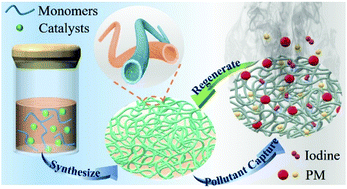Bifunctional conjugated microporous polymer based filters for highly efficient PM and gaseous iodine capture†
Abstract
Particulate matter (PM) pollution as a kind of air pollution is a major problem for global environmental management because it can carry toxic compounds and lead to biological death when inhaled. There is, therefore, an urgent need to develop safe, efficient and economical materials to capture PM from contaminated air. Herein, we synthesized two kinds of conjugated microporous polymers (CMPs) block type aerogel based nanotube air filters by a one-step method and applied them in the purification of dusty air. By regulating the test conditions to investigate the applicability of these materials, CMPs-based air filters were successfully synthesized and can work continuously for 48 h under hazardous conditions (concentration of PM2.5 > 1000 μg m−3). Filtration efficiencies are higher than 99.95% at ambient temperature and higher than 99.43% at a heating temperature of up to 500 °C. In addition to that, CMPs-based air filters can be regenerated several times and maintain a high efficiency level (PM2.5 > 99.96%) after washing with methanol. What is noteworthy is that the two CMPs-based filters can take up 172.73 wt% and 153.90 wt% gaseous iodine and exhibit their potential as bifunctional filtration materials for capturing both PM and volatile substances.



 Please wait while we load your content...
Please wait while we load your content...